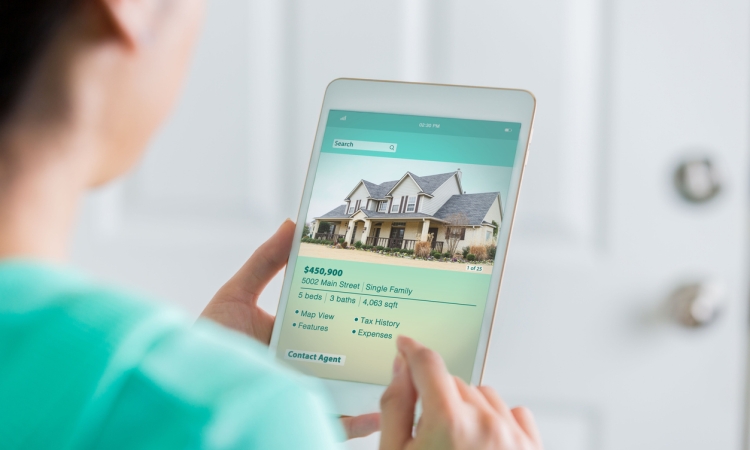The way people search for homes has undergone a dramatic transformation in recent years. Instead of driving from one open house to another, many buyers now explore properties from their couch through detailed virtual tours.
Virtual reality and digital real estate tools have enabled the online viewing, evaluation, and even purchase of homes. This shift is not only changing how people shop for homes but also how they plan their moves once the deal is done.
What is virtual reality in real estate?
Virtual reality in real estate refers to technology that lets buyers experience properties in a fully immersive, 3D environment. Using tools like Matterport 3D tours or headset-based simulations, buyers can virtually tour a home to get a sense of its layout, lighting, and design. These experiences create a lifelike sense of space that traditional photos or videos can’t match.
How does VR technology work in property buying?
A VR home tour works by combining panoramic photography, 3D modeling, and interactive elements to digitally recreate the home’s interior. You can move virtually from room to room, to explore the layout, features, and finishes. You can even customize wall colors or furniture placement through augmented reality (AR). Real estate agents and developers are increasingly leveraging this technology to connect with remote buyers and streamline their property marketing efforts.
Tip: Look for listings that include 3D or virtual tours to help narrow your search before visiting in person.
The rise of online house hunting
Digital platforms have become the first stop for nearly every homebuyer. From researching neighborhoods to exploring listings, the process often happens entirely online before a single in-person showing is scheduled. The best house hunting websites now feature immersive media, filters for school districts and commute times, and integrated tools for online mortgage pre-approval.
Why are virtual home tours becoming so popular?
Virtual tours appeal to busy people looking for efficient, convenient ways to house hunt. TYou can preview dozens of homes in one evening without the travel time and scheduling conflicts often associated with traditional tours. By combining walkability scores, crime maps, and cost-of-living comparisons, online research provides a more comprehensive picture of a community.
Tip: Use online neighborhood research tools to compare schools, safety, and commute times before deciding where to move.
Buying a house sight unseen: Convenience meets caution
 As technology advances, more people are comfortable buying homes sight unseen. Remote buyers relocating for work or moving across the country often rely on virtual tours, online inspections, and digital closing tools to complete their purchases. The process offers unmatched flexibility but also requires due diligence.
As technology advances, more people are comfortable buying homes sight unseen. Remote buyers relocating for work or moving across the country often rely on virtual tours, online inspections, and digital closing tools to complete their purchases. The process offers unmatched flexibility but also requires due diligence.
Can you buy a house entirely through virtual reality?
It’s possible to buy a home entirely through virtual reality, but it’s not without risks. While VR gives a realistic view of interiors, it can’t replace the tactile experience of walking through a property or exploring its surroundings. Remote home inspections, detailed video walkthroughs, and clear communication with agents are essential to reduce the risks of sight-unseen home purchases.
Tip: If you’re considering a sight-unseen purchase, schedule a remote inspection and review the report carefully before finalizing the deal.
How is the metaverse influencing real estate marketing?
The metaverse and extended reality technologies are creating new ways to experience properties beyond the screen. Developers and real estate firms now host interactive showings inside virtual worlds where buyers can explore multiple homes, customize finishes, and visualize design changes before construction even begins. This approach blends creativity, convenience, and cutting-edge technology in one immersive experience.
What’s the difference between VR, AR, MR, and XR?
Each of these technologies offers unique advantages that are transforming how buyers and sellers interact with properties:
- Virtual Reality (VR): Immerses buyers in a fully digital home model for realistic walkthroughs.
- Augmented Reality (AR): Layers digital elements—like furniture or paint colors—onto real environments.
- Mixed Reality (MR): Blends physical and digital views, allowing users to interact with 3D home models in real space.
- Extended Reality (XR): The umbrella term encompassing all these immersive technologies.
Together, these innovations redefine how buyers explore listings, visualize spaces, and make confident homebuying decisions.
Tip: Ask your agent if they use immersive or 3D visualization tools; it can help you picture design options before moving in.
Coordinating a move after a virtual purchase
Once you buy a home, the moving process often begins before you have seen the property in person. That means planning is key. Buyers who close remotely may need to coordinate their movers, deliveries, and storage before physically arriving.
Clear communication between agents, movers, and closing teams helps ensure a smooth transition. Look for an experienced, professional moving company capable of assisting clients in these scenarios by managing logistics and timelines when relocation follows a virtual home purchase.
Tip: Confirm your moving date early so your relocation aligns with your virtual or remote closing schedule.
Will you try virtual house hunting?
Online house hunting has moved beyond convenience. It’s reshaping the entire buying and moving experience. Virtual reality and digital real estate tools make it easier than ever to find a home from anywhere, but preparation and careful planning remain essential. As virtual tours and remote closings become more common, having a trusted moving partner ensures that your virtual search ends with a seamless real-world transition.


